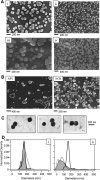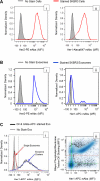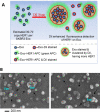Exosomes: improved methods to characterize their morphology, RNA content, and surface protein biomarkers
- PMID: 26332016
- PMCID: PMC4986832
- DOI: 10.1039/c5an00688k
Exosomes: improved methods to characterize their morphology, RNA content, and surface protein biomarkers
Abstract
As a type of secreted membrane vesicle, exosomes are an emerging mode of cell-to-cell communication. Yet as exosome samples are commonly contaminated with other extracellular vesicles, the biological roles of exosomes in regulating immunity and promoting oncogenesis remain controversial. Wondering whether existing methods could distort our view of exosome biology, we compared two direct methods for imaging extracellular vesicles and quantified the impact of different production and storage conditions on the quality of exosome samples. Scanning electron microscopy (SEM) was compared to transmission electron microscopy (TEM) as alternatives to examine the morphology of exosomes. Using SEM, we were able to distinguish exosomes from other contaminating extracellular vesicles based on the size distribution. More importantly, freezing of samples prior to SEM imaging made it more difficult to distinguish exosomes from extracellular vesicles secreted during cell death. In addition to morphology, the quality of RNA contained within the exosomes was characterized under different storage conditions, where freezing of samples also degraded RNA. Finally, we developed a new flow cytometry approach to assay transmembrane proteins on exosomes. While high-copy-number proteins could be readily detected, detecting low-copy-number proteins was improved using a lipophilic tracer that clustered exosomes. To illustrate this, we observed that exosomes derived from SKBR3 cells, a cell model for human HER2+ breast cancer, contained both HER1 and HER2 but at different levels of abundance. Collectively, these new methods will help to ensure a consistent framework to identify specific roles that exosomes play in regulating cell-to-cell communication.
Figures






Similar articles
-
Direct comparison of optical and electron microscopy methods for structural characterization of extracellular vesicles.J Struct Biol. 2020 Apr 1;210(1):107474. doi: 10.1016/j.jsb.2020.107474. Epub 2020 Feb 4. J Struct Biol. 2020. PMID: 32032755 Free PMC article.
-
[Contamination of exosome preparations, isolated from biological fluids].Biomed Khim. 2017 Jan;63(1):91-96. doi: 10.18097/PBMC2017630191. Biomed Khim. 2017. PMID: 28251957 Russian.
-
Cardiomyocyte microvesicles contain DNA/RNA and convey biological messages to target cells.PLoS One. 2012;7(4):e34653. doi: 10.1371/journal.pone.0034653. Epub 2012 Apr 10. PLoS One. 2012. PMID: 22506041 Free PMC article.
-
Ascent of atomic force microscopy as a nanoanalytical tool for exosomes and other extracellular vesicles.Nanotechnology. 2018 Apr 3;29(13):132001. doi: 10.1088/1361-6528/aaab06. Nanotechnology. 2018. PMID: 29376505 Review.
-
Plasma neuronal exosomes serve as biomarkers of cognitive impairment in HIV infection and Alzheimer's disease.J Neurovirol. 2019 Oct;25(5):702-709. doi: 10.1007/s13365-018-0695-4. Epub 2019 Jan 4. J Neurovirol. 2019. PMID: 30610738 Free PMC article. Review.
Cited by
-
Expression profiling & functional characterization of candidate miRNAs in serum exosomes among Indians with & without HIV-tuberculosis coinfection.Indian J Med Res. 2024 Jun;159(6):653-662. doi: 10.25259/IJMR_1281_23. Indian J Med Res. 2024. PMID: 39382473 Free PMC article.
-
Comparative analysis of tangential flow filtration and ultracentrifugation, both combined with subsequent size exclusion chromatography, for the isolation of small extracellular vesicles.J Extracell Vesicles. 2022 Sep;11(9):e12266. doi: 10.1002/jev2.12266. J Extracell Vesicles. 2022. PMID: 36124834 Free PMC article.
-
Extracellular Vesicle-Mediated Chemoresistance in Oral Squamous Cell Carcinoma.Front Mol Biosci. 2021 Mar 9;8:629888. doi: 10.3389/fmolb.2021.629888. eCollection 2021. Front Mol Biosci. 2021. PMID: 33768115 Free PMC article. Review.
-
To Protect and to Preserve: Novel Preservation Strategies for Extracellular Vesicles.Front Pharmacol. 2018 Oct 29;9:1199. doi: 10.3389/fphar.2018.01199. eCollection 2018. Front Pharmacol. 2018. PMID: 30420804 Free PMC article. Review.
-
miRNAs in Extracellular Vesicles from iPS-Derived Cardiac Progenitor Cells Effectively Reduce Fibrosis and Promote Angiogenesis in Infarcted Heart.Stem Cells Int. 2019 Nov 11;2019:3726392. doi: 10.1155/2019/3726392. eCollection 2019. Stem Cells Int. 2019. PMID: 31814833 Free PMC article.
References
Publication types
MeSH terms
Substances
Grants and funding
LinkOut - more resources
Full Text Sources
Other Literature Sources
Research Materials
Miscellaneous

